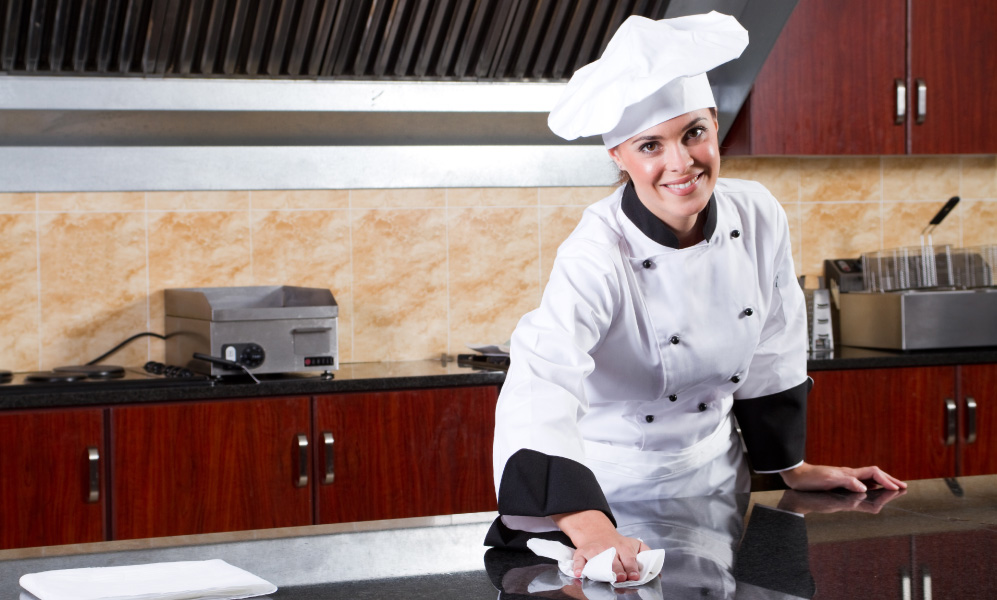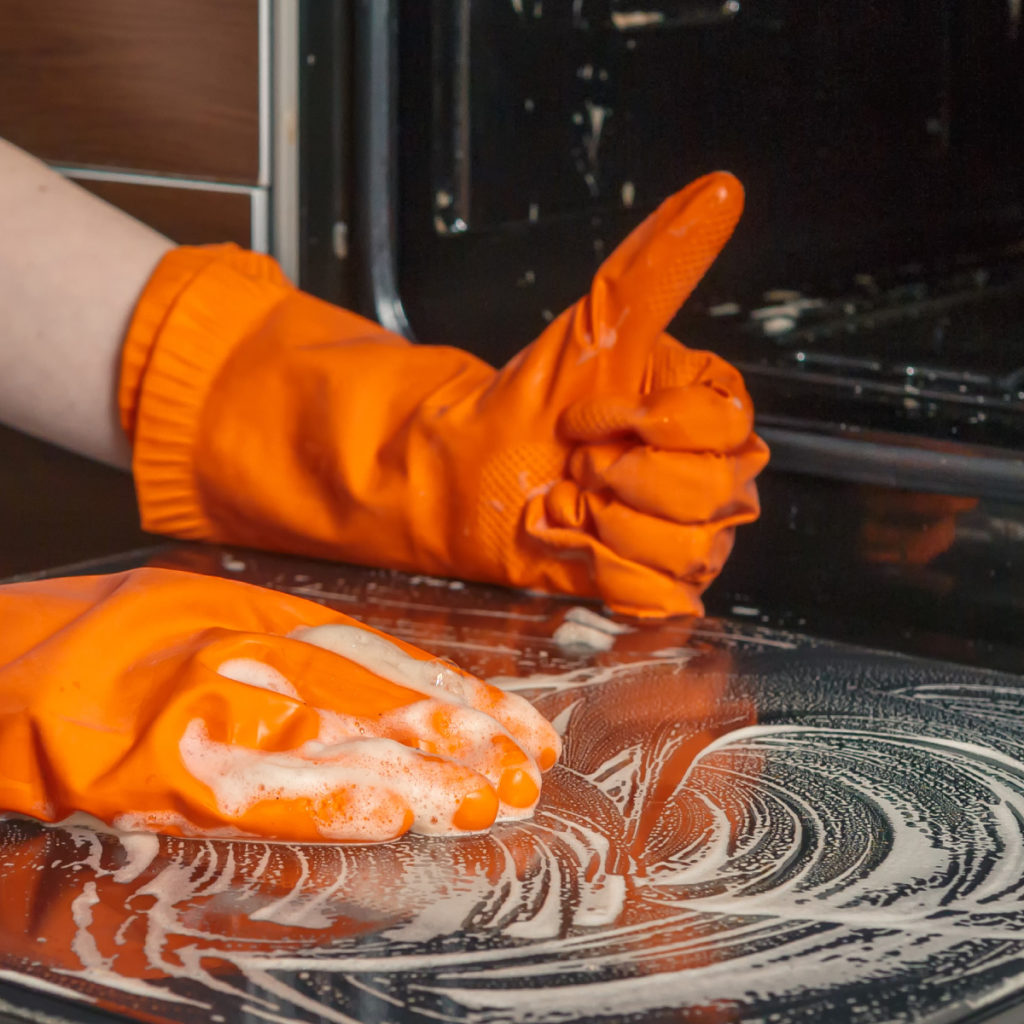The kitchen is a producing ground for bacteria and germs. Your kitchen may look tidy and clean, but any food preparation area is known to attract microorganisms that can cause foodborne illnesses. Kitchen sanitation is vital for good health but Sometimes microbes, especially faecal bacteria contaminate too fast within food items and cause spoilage.
How to keep your kitchen sanitized, clean & germ-free?

-
Gas Stove
The gas stove is one area that can become a breeding ground for infections over time. Experts recommend cleaning the stove after every meal with a mixture of soap or detergent and water. Soak burners and lids in warm soapy water for 30 minutes. Scrub buildup from burner heads and caps with a non-abrasive sponge or old toothbrush. This simple practice is a good way to keep your kitchen and the food you prepare clean and sanitary.
-
Kitchen Counters and Slabs
Kitchen countertops and dishes are where vegetables, fruits, and other ingredients are stored before washing. The kitchen tiles must be laid out to avoid contamination of the products with germs during the preparation of the recipes. Use a mixture of saltwater and lemon for best results. Gently remove any food residue with a spatula or scraper. Make sure to clean the countertops after cleaning so that they are completely dry.
-
Utensils & Storage containers
For the food safety of the kitchen, it is important to sanitize utensils and vessels in which food is stored. Mostly, lentils/beans and flours are frequently contaminated with pests, which can cause various foodborne illnesses. It is essential to verify that utensils are cleaned after use with soap or detergent-gel. Sanitize cutlery, metal utensils, pots, and pans by boiling in water for 10 minutes. In this case, chlorine bleach should not be used because it reacts with many metals and causes them to blacken. They should be fully dry before you put the food in them, to lessen spoilage.
-
Sanitizing the Floor
The kitchen floor can be one of the dirtiest and most germ-contaminated areas in the home. Just vacuuming and scrubbing may not be essential for cleaning your floor. A steam mop, like The Shark, is a good kitchen cleaning tool that uses a mixture of steam and floor cleaner to clean the floor.
-
Apparatus
Food Mixer, toasters, freezers, microwaves, etc. – any equipment utilized in the kitchen should be entirely hygienic. The microwave in specific can frequently become dirty. When sanitizing kitchen utensils and equipment, use boiling water or bleach. Specialists recommend using vinegar and a water mixer. Just microwave it in the bowl for a couple of minutes and by using a swab we remove all the stains.
For example:
- Refrigerators: The refrigerator should be thoroughly cleaned from time to time. After cleaning, pat dry with your bleach solution. Then the food must be returned. Spills should be cleaned up immediately. Do not allow food to spoil or get wet in the refrigerator.
- Complex devices, such as food processors, mixers, and mixers. The dishwasher is the best way to sanitize these items. Initially examine items carefully and remove any traces of food present. Then put the washable components of the items in the dishwasher.
What are tips for food safety and prevention from spoilage of food?
When it comes to food safety, not only the surrounding areas, but the food itself must be of the highest quality. To combat the risk of food contamination, it is advisable to take the necessary precautions, thoroughly cleaning vegetables and other food items before consumption. Home remedies may not be effective in this case.
The main way to spread contamination in the kitchen is with our hands. People often do not wash their hands before preparing food. And people generally do not wash their hands between handling potentially contaminated foods, such as meat, and other foods less likely to be contaminated, such as vegetables. This cross-contamination is the leading cause of foodborne illness.
Food safety and hygiene practices:
Safety measures in the handling, cooking and storage of food are essential to prevent foodborne illness. At all stages of food preparation, follow the four steps to keep food safe:
- Clean: Wash your hands and surfaces frequently.
- Separated: No cross-contamination
- Cook: Cook to the proper temperature.
- Cool: Cool immediately
Some Important Tips are:
1. Purchasing:
- Buy your food at trusted retail stores.
- Buy refrigerated or frozen foods after selecting your non-perishable items.
- Never choose meat and poultry in broken or leaking containers.
- Buy enough food for less than a few days.
- Do not buy bad or smelly food or meats with viscous material on their surface, as it indicates its circulation in a healthy way
- Buy only fresh fish, with bright eyes, flesh firm and flexible to the touch, and not slimy or smelly. Look at this when buying fish
- Do not buy vegetables that are bruised, stained, and fluffy to touch.
- Buy clean eggs that do not have cracks on the surface, as they will let bacteria in and contaminate the eggs.
- Select foods that have not passed the expiration date.
- Do not choose canned foods that are heavily crushed or puffed up.
- Avoid broken, leaking, and insect-infested food containers.
- Check that milk or bottled drinks are tightly closed.
- When shopping: keep raw foods in separate bags, away from ready-to-eat foods.
2. Preparation:
- Always wash your hands in processing food.
- Wash knives and cutting boards
- Wash knives well, especially after cutting raw meat.
- Use different plates to serve raw and cooked foods.
- Separate raw from cooked foods to avoid cross-contamination
3. Cooking:
- Cook food thoroughly, especially meat.
- Cook food at high temperatures (above 75 ° C)
- Pink meat is undercooked.
- Make sure the meat and poultry centre are well done.
- Reheat stored cooked food and bring it to a boil.
- Use garden-fresh vegetables and fruits as a substitute for canned or frozen.
- Use fresh meats despite processed meat.
- Read the food label carefully
4. Refrigeration:
- keep a space in the refrigerator for cool air movement
- Place raw foods in tightly wrapped plastic bags
- In the refrigerator: place dry food on top of wet food.
- Distribute excess cooked food after cooking and refrigerate quickly.
- Keep cold foods in the refrigerator or on a bed of ice until it is time to serve them.
- Thaw food safely in the refrigerator overnight.
- Marinate foods safely in a covered container in the refrigerator.
5. Serving:
- Hot food should be kept at 60 ° C or hotter.
- Cold foods should be kept at or below 4.4 ° C
- Perishable foods should not be placed outside for more than 2 hours at room temperature.
6. Leftovers:
- Throw away food that has been left at room temperature for more than 3 hours.
- Place food in shallow containers and immediately in the refrigerator or freezer to cool quickly.
- Use cooked leftovers within 4 days
- Reheat leftovers to 73 ° C
7. Storage:
- Use food-safe airtight, microwave-safe containers
- Use paper bags only once
- Food stored in warehouses before being transported and distributed to customers
- For sauces, first put them in a plastic bag and then put them in a container.
- Wash all fresh fruits and vegetables before packing them in boxes.
- Be alert to food allergies and avoid cross-contamination of items that can cause an allergic reaction.
- The product can also be damaged or spoiled by careless handling or changes in storage conditions, such as light, humidity, and temperature, so keep all of these conditions.







